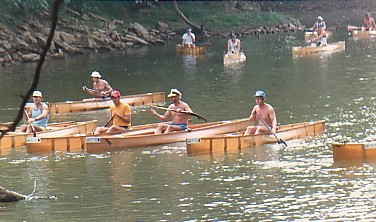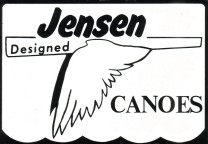Canoe & Kayak - May 27, 2004
Gene Jensen, the father of the modern canoe, died peacefully on May 15 at his home in Inverness, Florida. He’s survived by his wife Audrey and their four children, eleven grandchildren, and four great-grandchildren.
Jensen was a legend of the canoe world. A founding member of the Minnesota Canoe Association, he spent most of his adult life designing, building, and racing canoes. Although Jensen is best known for his racing innovations, his improved canoe designs and ergonomic bent-shaft paddles would eventually trickle down to recreational paddlers around the world. So, too, would the more efficient paddling techniques pioneered by Gene and his partners.
In 1948, Gene and his partner Tom Estes won the 450-mile Aquatennial Canoe Derby, a ten-day stage race that ran from Bemidji to Minneapolis. It was their first major victory. Later, with Estes and a number of other partners, Jensen won major races all over the US and Canada.
Jensen’s grandson has set up a Web site with photos and stories about Gene Jensen, and he’s inviting more recollections. See it at www.jensencanoes.com.
Back then, winners’ photos made the front page of big-city newspapers-and not just the front page of the sports section. It was a time when canoes, paddles, and technique were all evolving rapidly. And over the decades to come, Gene Jensen would be behind most of the sport’s major advances.
Jensen was the archetypal lone inventor working in a garage. In the days before computerized design tools, he used a pencil and a bent sawblade to draw his forms on huge sheets of white butcher’s paper. “Give me six nails and a Swedish sawblade,” Jensen once said, “and I can draw anything.”
Originally, many of his design innovations were intended just for his own use, as a secret advantage that could help him and his partners win races. Eventually, however, he began building and designing canoes full-time. His hand-crafted, cedar-and-fiberglass canoes were beautiful, light as a feather, and faster than anything on the water.

Today, Jensen’s efficient, fun-to-paddle designs have become popular all over the US and Canada. And every year, a few are even shipped to discerning paddlers in Europe and Asia. One of Gene’s most popular designs is known as simply “the Jensen.”
The one canoe you’re most likely to see in the BWCA and Quetico is Wenonah’s Jensen-designed Minnesota II; a similar Jensen design from Clipper has become popular in the Northwest. “That canoe is something I really feel good about,” Jensen once said. “It got a lot of people out there on the water. And that’s what matters most.”

At any marathon canoe race in North America, over 90% of the canoes at the starting line are Jensen designs. Gene kept racing on into his fifties and sixties; he sometimes found his design success a mixed blessing. “At Nationals, or at a big race out in Quebec,” he once admitted, “it was quite a feeling to look around and see all those hundreds of racers in canoes that I’d designed. The bad news, of course, was that then I had to race against them.”
Jensen also invented the bent-shaft paddle that’s now used universally by marathon racers. These more efficient, ergonomic paddles have also become increasingly popular with recreational paddlers. They’re even used by outrigger canoe racers in places as far from Minnesota as Hawaii, Tahiti, and South Africa. In the early seventies, when Jensen and his partner showed up with their odd-looking paddles at a major race in Quebec, everyone laughed – until they won. The next year, every team used them.
Today, Wenonah and Clipper build Jensen-designed canoes from high-tech materials like Kevlar and carbon fiber; some of the racing models weigh less than 30 pounds. But in the forties and fifties, Jensen built his state-of-the-art racing canoes from wood. They weighed around 80 pounds in the spring – and 90 to 100 pounds after they’d been soaking up water for a summer.
Back then, Jensen and his partners often began their training runs by heading up the Mississippi from the north edge of Minneapolis. Longer training sessions sometimes meant paddling against the current for several hours before turning around. “Today’s racers train a lot smarter,” Jensen once said. “But they don’t train harder.”



